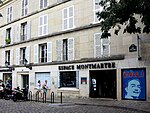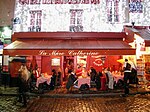Dalí Universe

The Dalí Universe is a collection of Salvador Dalí artworks consisting mainly of sculptures, curated by Beniamino Levi, Italian gallerist and collector. Opened in 2000 in London, in 2010 the Dalí Universe has permanently relocated to the Espace Dalí in Paris, France. Part of the collection, however, is sometimes exhibited at international locations. The exhibition includes mainly bronze sculptures, drawings, lithographs and glass and gold sculptures. The last international exhibitions were held in Beijing, China, in 2018, and in Liège, Belgium, in 2016. Previous locations have also included Singapore, Taipei, Shanghai, New York City, Florence and Venice.
Excerpt from the Wikipedia article Dalí Universe (License: CC BY-SA 3.0, Authors, Images).Dalí Universe
Place du Calvaire, Paris Quartier de Clignancourt (Paris)
Geographical coordinates (GPS) Address Phone number Website Nearby Places Show on map
Geographical coordinates (GPS)
| Latitude | Longitude |
|---|---|
| N 48.886527777778 ° | E 2.3397222222222 ° |
Address
Espace Dali
Place du Calvaire
75018 Paris, Quartier de Clignancourt (Paris)
Ile-de-France, France
Open on Google Maps











